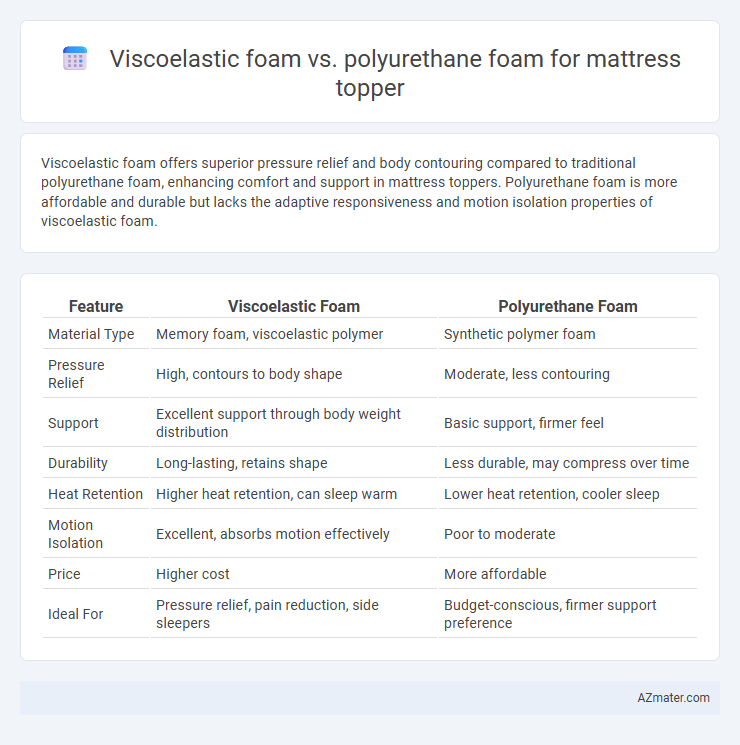Viscoelastic foam offers superior pressure relief and body contouring compared to traditional polyurethane foam, enhancing comfort and support in mattress toppers. Polyurethane foam is more affordable and durable but lacks the adaptive responsiveness and motion isolation properties of viscoelastic foam.
Table of Comparison
| Feature | Viscoelastic Foam | Polyurethane Foam |
|---|---|---|
| Material Type | Memory foam, viscoelastic polymer | Synthetic polymer foam |
| Pressure Relief | High, contours to body shape | Moderate, less contouring |
| Support | Excellent support through body weight distribution | Basic support, firmer feel |
| Durability | Long-lasting, retains shape | Less durable, may compress over time |
| Heat Retention | Higher heat retention, can sleep warm | Lower heat retention, cooler sleep |
| Motion Isolation | Excellent, absorbs motion effectively | Poor to moderate |
| Price | Higher cost | More affordable |
| Ideal For | Pressure relief, pain reduction, side sleepers | Budget-conscious, firmer support preference |
Introduction to Mattress Topper Materials
Viscoelastic foam, commonly known as memory foam, offers superior contouring and pressure relief by responding to body heat and weight, making it a popular choice for mattress toppers. Polyurethane foam, a more traditional material, provides firmer support with faster response time and generally costs less, but lacks the adaptive comfort of viscoelastic foam. Understanding the key differences in density, durability, and temperature sensitivity helps consumers choose the ideal mattress topper material for enhanced sleep quality.
What is Viscoelastic Foam?
Viscoelastic foam, commonly known as memory foam, is a high-density polyurethane material infused with viscoelastic chemicals that respond to body heat and pressure, providing contouring support and pressure relief. Unlike standard polyurethane foam, viscoelastic foam slowly returns to its original shape, enhancing comfort by evenly distributing body weight and reducing motion transfer. This unique combination of temperature sensitivity and slow recovery makes viscoelastic foam an ideal choice for mattress toppers targeting improved spinal alignment and reduced pressure points.
Understanding Polyurethane Foam
Polyurethane foam, a versatile and widely used material in mattress toppers, offers a balance of comfort and support with its open-cell structure that promotes breathability and durability. Unlike viscoelastic foam, which contours precisely to body shape and relieves pressure, polyurethane foam provides a firmer, more resilient surface that resists sagging over time. Its affordability and range of density options make polyurethane foam a practical choice for those seeking moderate cushioning without heat retention issues.
Comfort Comparison: Viscoelastic vs Polyurethane
Viscoelastic foam, also known as memory foam, adapts closely to body contours, offering superior pressure relief and support compared to traditional polyurethane foam. Polyurethane foam provides a firmer, more resilient feel but lacks the same level of contouring and motion isolation found in viscoelastic materials. For mattress toppers, viscoelastic foam enhances overall comfort by reducing pressure points and improving spinal alignment, while polyurethane foam delivers a more basic cushioning effect.
Support and Pressure Relief
Viscoelastic foam, often known as memory foam, offers superior pressure relief by contouring closely to the body's shape, evenly distributing weight and reducing pressure points. Polyurethane foam provides firmer support with more bounce, making it suitable for those who prefer a responsive feel and enhanced spinal alignment. Choosing between the two depends on individual needs for pressure alleviation versus overall support and durability in a mattress topper.
Durability and Longevity
Viscoelastic foam, also known as memory foam, offers superior durability due to its high density and ability to retain shape over time, often lasting 8 to 10 years with consistent use. Polyurethane foam, while more affordable, typically has a shorter lifespan of 3 to 5 years due to lower density and faster degradation under pressure. The long-term resilience of viscoelastic foam makes it a preferred choice for mattress toppers aimed at sustained support and comfort.
Breathability and Temperature Regulation
Viscoelastic foam, also known as memory foam, often retains heat due to its dense structure, which can limit breathability and temperature regulation. In contrast, polyurethane foam typically features an open-cell design that promotes better airflow, enhancing breathability and preventing heat buildup. Selecting a mattress topper with gel-infused or ventilated viscoelastic foam can improve temperature regulation, but polyurethane foam generally offers superior cooling properties for sleepers prone to overheating.
Allergen Resistance and Health Factors
Viscoelastic foam, commonly known as memory foam, offers superior allergen resistance due to its dense structure that inhibits dust mites, mold, and bacteria accumulation, benefiting individuals with asthma or allergies. In contrast, polyurethane foam is more porous, which may allow allergens to penetrate, potentially triggering respiratory issues. Health factors favor viscoelastic foam as it promotes better spinal alignment and pressure relief without off-gassing harmful chemicals often associated with lower-quality polyurethane foam products.
Price Differences and Value for Money
Viscoelastic foam mattress toppers typically cost 20-40% more than polyurethane foam due to their superior pressure relief and durability. Despite the higher initial price, viscoelastic foam offers enhanced comfort and longevity, providing better value for money over time. Polyurethane foam is budget-friendly but tends to compress faster, reducing overall mattress support and lifespan.
Which Mattress Topper Should You Choose?
Viscoelastic foam, also known as memory foam, provides superior pressure relief and conforms closely to body contours, making it ideal for individuals seeking enhanced comfort and support. Polyurethane foam tends to be lighter and more affordable, offering moderate cushioning but less contouring ability and durability compared to viscoelastic foam. Choose viscoelastic foam mattress toppers for pain relief and pressure distribution, while polyurethane foam suits those prioritizing budget and lighter weight options.

Infographic: Viscoelastic foam vs Polyurethane foam for Mattress topper
 azmater.com
azmater.com